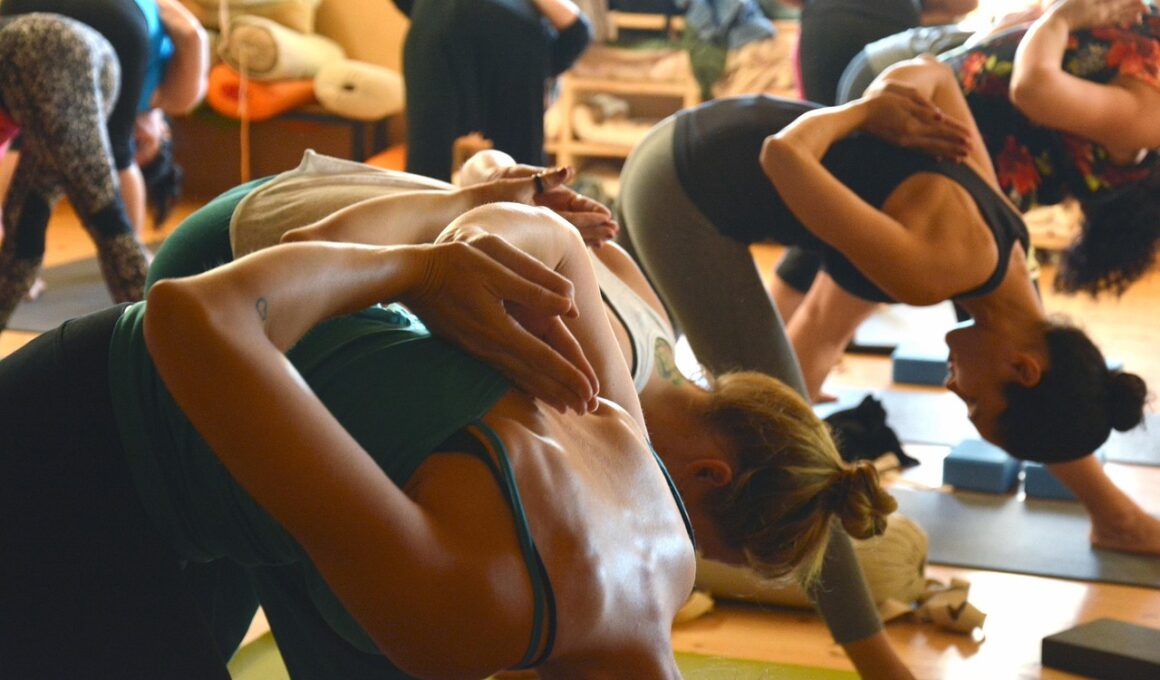Incorporating Mindfulness in Group Fitness to Enhance Motivation
In the realm of group fitness, motivation can often ebb and flow among participants. As instructors, finding ways to enhance this motivation is crucial for fostering a supportive and engaged environment. One effective way to achieve this is through the integration of mindfulness practices into workouts. Mindfulness, often defined as the practice of being present and fully engaged in the moment, can significantly impact individuals’ motivation levels. Participants who are encouraged to focus on their breathing and movements can develop a deeper connection with their workout, subsequently enhancing their overall experience. By promoting awareness during classes, individuals may set aside distractions and self-doubt, allowing them to engage more fully in their fitness journey. Furthermore, incorporating moments of reflection during sessions can provide participants with the opportunity to acknowledge their progress and achievements. As members of the fitness community embrace this approach, they may experience heightened motivation levels and improved outcomes. Ultimately, instructors who weave mindfulness into their classes can create more satisfying and impactful experiences, encouraging participants to consistently show up and give their best efforts week after week.
One effective method to integrate mindfulness into group fitness is through structured breathing techniques. By guiding participants to practice controlled breathing at the beginning of a session, instructors can help them transition from their daily stresses into a focused workout mindset. This practice fosters an enhanced awareness of their body, enabling members to connect with their physical capabilities more profoundly. For instance, pairing breathing exercises with movement can cultivate a sense of rhythm and flow during workouts, further propelling engagement. Instructors might also opt to introduce a few moments of stillness or reflection during class, providing participants the chance to assess how they feel both physically and emotionally. This practice of checking in can encourage them to listen to their bodies, thus promoting a more mindful experience. Furthermore, discussing the psychological benefits of mindfulness in relation to fitness may motivate members to adopt these techniques. When individuals understand that adopting mindfulness can lead to achieving their fitness goals and enhancing their overall well-being, they may be more inclined to embrace it as part of their group fitness journey.
Incorporating Mindfulness into Group Challenges
Group fitness challenges can be an effective way to foster camaraderie and improve motivation among participants. Integrating mindfulness into these challenges can enhance the experience, encouraging participants to push their limits while remaining present and aware of their capabilities. For instance, during a fitness challenge, instructors may introduce moments of mindfulness through affirmations or positive self-talk. Encouraging participants to visualize their success as they work towards their goals fosters a deeper connection with their fitness aspirations. Additionally, setting intentions at the beginning of challenges can help participants remain focused and motivated throughout the process. Moreover, group discussions can be incorporated to share experiences, reinforcing a sense of community and shared motivation. These connections will foster a supportive atmosphere where participants uplift each other throughout the challenge. It is crucial to remind group members to honor their individual journeys and progress, regardless of others’ achievements. By encouraging mindfulness in group fitness challenges, instructors can promote a healthy mindset and a supportive environment, ultimately leading to higher motivation and improved outcomes for all involved.
Furthermore, implementing mindfulness during recovery periods in group fitness is equally important for motivation. Recovery moments allow participants to reflect on their progress, breathe deeply, and appreciate their bodies’ efforts throughout the workout. Instructors can effectively use these moments to reinforce the importance of recognizing one’s achievements, fostering an increased sense of self-worth and motivation. Group leaders might introduce relaxation exercises such as guided imagery, allowing participants to visualize their goals and dream about their ideal fitness journeys. By weaving these practices into the recovery phase, participants may feel more connected to their motivations and aspirations. Moreover, this sense of connection can foster resilience and determination during challenging workouts. As participants learn to appreciate their progress, they may approach future challenges with renewed vigor, instilling a cycle of motivation that begets more motivation. By making mindfulness a priority in recovery, fitness instructors can seriously impact motivation levels and the overall satisfaction of group members as they work towards their fitness goals together.
Creating a Mindful Group Atmosphere
Fostering a mindful environment positively influences participants’ motivation in group fitness classes. Instructors can create a space that encourages mindfulness by using calming music, affirmations, and mindful movement. It’s essential to establish an atmosphere that promotes relaxation and focus, making it easier for participants to engage with their workouts. Encouraging free expression of emotions and thoughts allows individuals to feel comfortable and connected during sessions. Utilizing positive reinforcement and community engagement fosters a sense of belonging, promoting motivation and encouraging participants to pursue their fitness journeys wholeheartedly. Furthermore, inclusivity is crucial in building a mindful community. Recognizing that each participant has unique goals and challenges creates a supportive atmosphere that inspires motivation. Instructors should encourage participants to embrace their journeys while understanding their peers’ differences as well. When individuals feel valued and accepted within their group, they may be more inclined to commit to the shared fitness experience. Ultimately, cultivating a mindful and supportive environment can significantly influence motivation, leading to lasting changes in group fitness participants’ practices and approaches.
Instructors can also employ mindfulness techniques through creative workouts that challenge both mind and body. By incorporating exercises that require concentration and focus, participants can develop a mindful connection to their movements. For example, dance, yoga, or martial arts classes can engage participants’ minds through rhythm, breath control, and intention. Instructors can emphasize the importance of awareness during workouts, making adjustments to routines that promote presence and flow. Slow, deliberate movements can enhance mindfulness, encouraging participants to appreciate their bodies and capabilities as they work towards their fitness goals. This prioritization of connection greatly improves motivation, as participants are inspired to embrace their physical capabilities. Ensuring that workouts contain an element of mental challenge alongside physical exertion will engage everyone on multiple levels, enhancing the overall fitness experience. When participants leave feeling inspired and motivated, it directly correlates with their ability to succeed. By regularly integrating such methods, instructors will create lasting impacts on motivation levels within their group fitness classes, ultimately leading to improved health and wellness across the board.
Conclusion: The Role of Mindfulness in Fitness
Ultimately, incorporating mindfulness into group fitness can have profound effects on motivation and emotional well-being. As participants engage in intentional practices, they develop a deeper connection with themselves, their peers, and their fitness journeys. This holistic approach can facilitate a supportive group atmosphere, enhancing motivation and increasing commitment to individual fitness goals. Mindfulness fosters a greater appreciation for each person’s unique journey, helping build a resilient and empowered fitness community. As instructors, taking the time to emphasize mindfulness can lead to more engaged participants who are motivated to push their limits and achieve their aspirations. Encouraging mindfulness in fitness classes can empower individuals to cultivate life skills that extend beyond the gym, enriching their daily lives and promoting an overall positive attitude towards physical activity. By combining mindfulness with group fitness, instructors can help participants create a fulfilling fitness experience. Therefore, embracing mindfulness in group workouts is not just a technique; rather, it is a transformative approach that can redefine the way individuals connect with their fitness journeys.
This is an additional placeholder paragraph to meet requirements.


